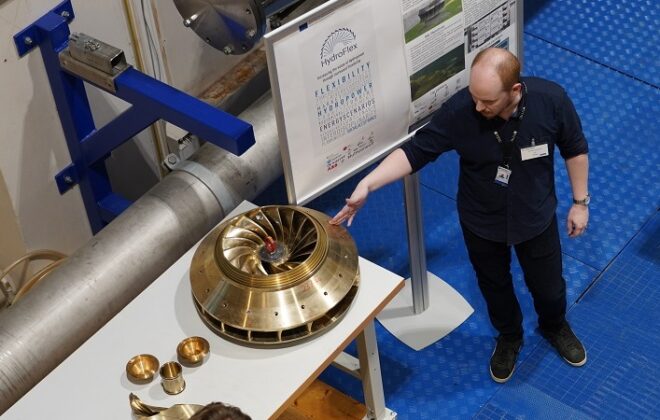Keeping cool during extreme heat

To fix a cooling problem in for example electronic devices, we have experimented with a carpet of nano-wires. Guess what, it works.
There are situations where even when you spray a very hot surface with water to cool it, it will not work. This extremely hot situation can occur inside small systems like electronic devices or even large systems like power plants. The droplets are simply not able to land on the hot surface.

When the droplet touches the surface it instantly begins to evaporate, creating a vapor cushion below it. This vapor cushion prevents the droplet to get in contact with the surface, and thus prevents it from removing the heat.
The phenomenon was observed 260 years ago by Dr. Johann Gottlab Leidenfrost and is therefore called the Leidenfrost effect. However, the physics of the process remains elusive.
In our recent research article we show that if we add a pattern of nano-wires to the surface, the liquid spreads on the surface and the Leidenfrost temperature can be increased almost 100oC. Why is this good? The droplets can cool down the electronics at higher temperatures, that’s why.
Making a nano-wire carpet
We have modified a surface with nano-wires. To give a comparison: A human hair has a diameter of about 0.1mm. In our case, we have created a kind of hair 500 times smaller on the surface reaching 0.0002 mm (meaning 200 nano metres) and only 0.0003 mm in length.

The nano-wires were made with Silicon in the NTNU Nanolab. When we scan with an electron microscope, the surface looks exactly like a carpet. This structure is obviously not visible to the naked eye! In the illustration, you can see a scanned electron microscope view of the surface with nano-wires (marked with nano measurement units).
Like droplets on a paper towel
We have tirelessly made tests and timelines of evaporation of a water droplet above a hot surface. While a plain surface with no nano-wires shows a Leidenfrost point at a temperature of 210°C, the surface with nano-wires is able to shift the Leidenfrost point of almost 100°C.
This shift is attributed to how the nanowires promote the liquid to spread on the surface, similar to the effect of a droplet touching a paper towel. This implies that the surface with nano-wires can be cooled down at even higher temperatures.
Our research suggests that controlling the liquid spreading on the surface might allow to control the elusive Leidenfrost phenomena. But can we shift the temperature to even higher temperature? This is one of the many questions that bring us to the lab every day.
The details of the study are published in Appl. Phys. Lett. 113, 253703 (2018).
Blog post originally published on www.ntnutechzone.no on January 22nd, 2019

Manuel Auliano
Manuel Auliano is a PhD Candidate at NTNU – Department of Energy and Process Engineering belonging to the Thermal Two-Phase Flow Laboratory (ThTPFLab).

Damiano Auliano
Damiano Auliano is a PhD Candidate at NTNU – Department of Energy and Process Engineering belonging to the Thermal Two-Phase Flow Laboratory (ThTPFLab).
Tags In
Search
Søk
Categories
- Arctic Research
- Arkitektur
- Bærekraft
- Bioingeniørfag
- Biologi
- Biology
- Biomedical Laboratory Science
- Biotechnology
- Bioteknologi
- Chemical Engineering
- Chemistry
- Climate
- Computer Science
- Datateknologi
- Digital
- Elektronikk
- Energi
- Energi
- Energy
- Engineering
- Engineering
- Environment
- Food Science
- Forskning
- Fysikk
- Fysikk
- Havbruk
- Informasjonsteknologi
- Informasjonsteknologi
- Ingeniørvitenskap
- Kjemi
- Kjemisk prosessteknologi
- Kjemisk prosessteknologi
- Kreftbehandling
- Kybernetikk
- Marine Technology
- Materialer
- Materials Science
- Materialteknologi
- Matvitenskap
- Meninger
- Miljø
- Min ph.d.
- My PhD
- My PhD
- My postdoc
- Nanotechnology
- Nanoteknologi
- Ocean
- Oil and gas
- Physics
- Research
- Simulering og visualisering
- Spør en forsker
- Studentliv
- Sustainability
- Ukategorisert
- Universitetsliv
- University Life
Kategorier
- Arctic Research
- Arkitektur
- Bærekraft
- Bioingeniørfag
- Biologi
- Biology
- Biomedical Laboratory Science
- Biotechnology
- Bioteknologi
- Chemical Engineering
- Chemistry
- Climate
- Computer Science
- Datateknologi
- Digital
- Elektronikk
- Energi
- Energi
- Energy
- Engineering
- Engineering
- Environment
- Food Science
- Forskning
- Fysikk
- Fysikk
- Havbruk
- Informasjonsteknologi
- Informasjonsteknologi
- Ingeniørvitenskap
- Kjemi
- Kjemisk prosessteknologi
- Kjemisk prosessteknologi
- Kreftbehandling
- Kybernetikk
- Marine Technology
- Materialer
- Materials Science
- Materialteknologi
- Matvitenskap
- Meninger
- Miljø
- Min ph.d.
- My PhD
- My PhD
- My postdoc
- Nanotechnology
- Nanoteknologi
- Ocean
- Oil and gas
- Physics
- Research
- Simulering og visualisering
- Spør en forsker
- Studentliv
- Sustainability
- Ukategorisert
- Universitetsliv
- University Life



